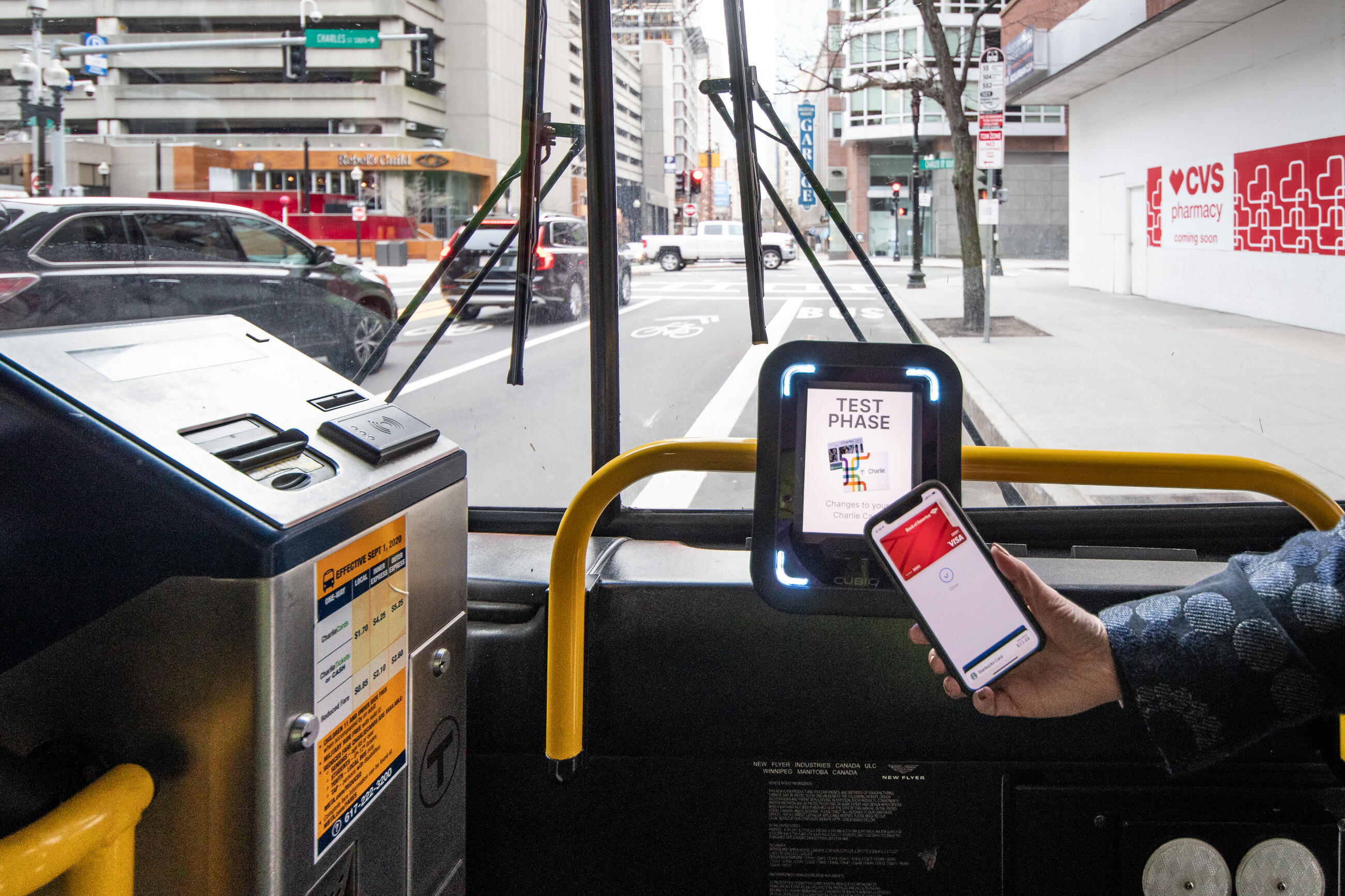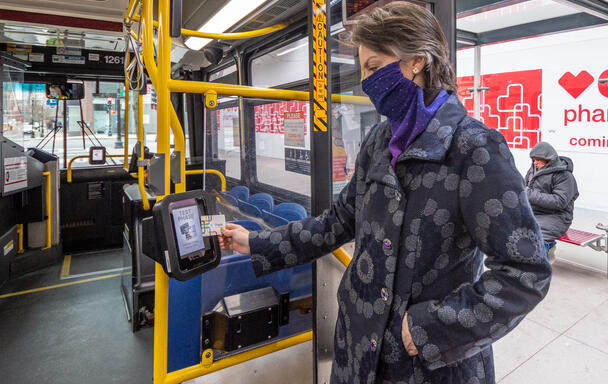Get Involved

The only fare system that works is a fare system that works for you, and we want you to tell us what you need.
We’ll be collecting feedback through focus groups, community meetings, and by asking riders to reach out to us directly. And it’s not just the technology we’ll be seeking feedback on—we also want you to help us update our policies surrounding the new fare system.
There are several ways we’re working with the public:
Building a Better T
As part of our $9.6 billion, 5-year capital investment plan, we're renovating stations, modernizing fare collection systems, upgrading services for our buses, subways, and ferries, and improving the accessibility of the entire system.
Provide Input on Policy Changes to Fare Collection
We’re making some policy changes in order to take full advantage of our new fare collection technology. We want to hear how these policies impact you so that we can improve our plans and smooth the transition to the new system.
Learn about each of our policies below.
We're proposing changes to our fare policies to support Fare Transformation:
- Ending passbacks: We’re discontinuing the ability to tap multiple riders through a gate with one card (“passback”). This will allow us to introduce mobile and contactless payments and integrate the Commuter Rail without creating pricing errors.
- Fare media per rider: Riders aged 12 and older will need to have their own fare media to provide proof of payment and to ensure there are no duplicate charges at fare gates and on fare readers.
- “One more trip” protection on Charlie Cards: The new fare media will allow riders to board with low/zero balance to improve convenience and avoid leaving riders stranded.
- $3 Fare media fee and free card distribution: There will be a $3 card cost per new Charlie Card and Mobile Charlie Card, with some exceptions. *
*We recognize that the new card cost may be a burden for some riders, and we are currently developing a plan to distribute free Charlie Cards to minority and low-income communities through partner organizations. Cards will continue to be free to Reduced Fare Riders and for all riders purchasing a 1-Day Link Pass on a new Charlie Card.
Learn more about the fare media changes
We held public meetings in March 2022 to discuss these changes. You can continue to provide feedback by sending comments to publicengagement@mbta.com.
In the future, riders will be able to purchase their fares and passes online, via their smartphones, and with contactless credit/debit cards. And though we’re removing fare boxes from vehicles, we’re preserving the ability to pay in cash by introducing more places to load cash onto your Charlie Card than ever before:
- A larger, more robust network of retailers
- Updated in-station fare vending machines that dispense Charlie Cards
- New streetscape fare vending machines at bus stops and Green Line stations
We recently conducted a sales network analysis to identify where we should add new sales locations and what those locations should offer (for example, a fare vending machine versus a retailer).
Now, we need your help to make sure our analysis didn’t miss any critical locations. As part of this outreach process, we’re collecting feedback and suggestions from riders about the retail locations we’re proposing.
We’re installing new readers at every door on Green Line trolleys and buses. This will allow customers to board at every door, but it also means the trolley or bus driver cannot check that everyone pays their fare.
Our solution for fare verification in our new system is to have MBTA employees board vehicles at random and ask everyone to tap their card or phone on a handheld device to verify their payment. However, as we begin this policy, we want to make sure that it’s done in an equitable and efficient way.
In January 2021, Governor Baker signed a law decriminalizing fare evasion on the T. Violators will instead be issued a non-criminal citation with a fine proportionate to the nature of the offense. The law also gave the MBTA the regulatory authority to set fine levels.
With this new authority, the MBTA is proposing a new regulation to decrease fine levels. Riders can review and provide feedback on our proposed regulations before they are finalized.
We held a virtual public hearing about this proposal on April 15, 2021. You can view a recording of the hearing below and submit comments by emailing us at fareregulations@mbta.com.
Our new payment system will introduce a lot of new technology, which means we’ll be able to collect more data about our riders to help us make better decisions.
Any data we collect will be for a specific purpose, and kept only as long as it serves that purpose. Some data may be aggregated to remove any personal information and shared with groups or universities that use it for research purposes.
More data means more responsibility—and we’re committed to maintaining our riders’ privacy. So, we’re rewriting our current Privacy Policy to be more representative of our modern transit system and to better protect riders. As we write it, we need your feedback to help us understand your concerns and how these policies impact you.
Throughout spring 2021, we worked with the public to collect rider feedback in three focus areas: our retail sales network, fare payment verification, and fare rules and policies.
User Testing
User testing is an important part of any technology project, and it helps us make sure that the system we’re designing and building works for the people who need to use it—people like you.
Learn about our process, our participants, and our findings below.
- We gather initial customer feedback in focus groups and demos.
- We incorporate that feedback into the system design and requirements.
- We work with a professional usability testing agency to create a list of actions riders will need to perform when they use the system in the real world.
- We ask a diverse group of participants to perform those actions as they would in real life.
- Researchers, project teams, and MBTA stakeholders observe those tests, note any problems, and produce a test report with our findings.
- We use the reports to develop a usability improvement plan.
- We improve the design based on our findings and analysis.
- If the changes are significant, we test again.
Our user testing participants should be representative of real MBTA riders. This means we recruit customers who represent diversity in:
- Race
- Geography
- Socio-economic status
- Education level
- Age
- Language
- Ability
- MBTA use (frequency and mode of transit)
- Preferred payment method (cash, credit/debit card, Charlie Ticket, Charlie Card)
We also do user testing with staff who need to use the new system as part of their jobs.
We perform user tests on all new hardware and software. Based on previous user testing, we’ve already made some changes to our initial designs:
- Riders expect screens to always be touch screens, so we modified our designs so every fare vending machine features a touch screen.
- Some riders were confused by the online registration process, so we clarified the wording and design of the screens so they could better understand their options.
- Some riders had a hard time grabbing their card and receipt in the initial machine design, so we raised the height of the ticket tray and adjusted a spring on the door so it would open wider.
These are just a few examples of how we’ve incorporated feedback from user testing into our designs. User testing is one of the best ways we can make sure that we’re designing and building a system that makes your experience on the T better.
Be a Part of Fare Transformation
Want to sign up for emails or join an upcoming focus group? Fill out this short form to tell us how you'd like to get involved.
Fill out the formPublic Engagement Events
Throughout the project, we’ll share updates whenever there’s an opportunity for you to get involved, whether it be a focus group, street team, or community meeting.
See a list of past and upcoming events below.
Past Events
Additional Resources
View more information on our outreach initiatives, policies, and research findings below.
Analysis of Ticket and Cash Use on the T (March 2019)
Proposed Sales Network Title VI Equity Analysis
2022 Proposed Fare Payment Options and Changes (English)
2022 Proposed Fare Payment Options and Changes (Spanish)
2022 Proposed Fare Payment Options and Changes (Chinese Simplified)
2022 Proposed Fare Payment Options and Changes (Chinese Traditional)
2022 Proposed Fare Payment Options and Changes (Haitian)
2022 Proposed Fare Payment Options and Changes (French)
Contact Us
Do you have general feedback you'd like to share with us directly? Email us at charlie@mbta.com.
You can also fill out a short form to sign up for updates or participate in an upcoming public outreach event.
Related Projects
Fare Transformation
Fare Transformation will make it easy for you to tap and board at any door with a fare card, smartphone, or contactless credit card.
Join Our Next Meeting
We're asking the public to provide feedback as we roll out the Fare Transformation project. Please join us at our next meeting.
Building a Better T
As part of our $9.6 billion, 5-year capital investment plan, we're renovating stations, modernizing fare collection systems, upgrading services for our buses, subways, and ferries, and improving the accessibility of the entire system.
Related Projects
Fare Transformation
Fare Transformation will make it easy for you to tap and board at any door with a fare card, smartphone, or contactless credit card.
Join Our Next Meeting
We're asking the public to provide feedback as we roll out the Fare Transformation project. Please join us at our next meeting.

